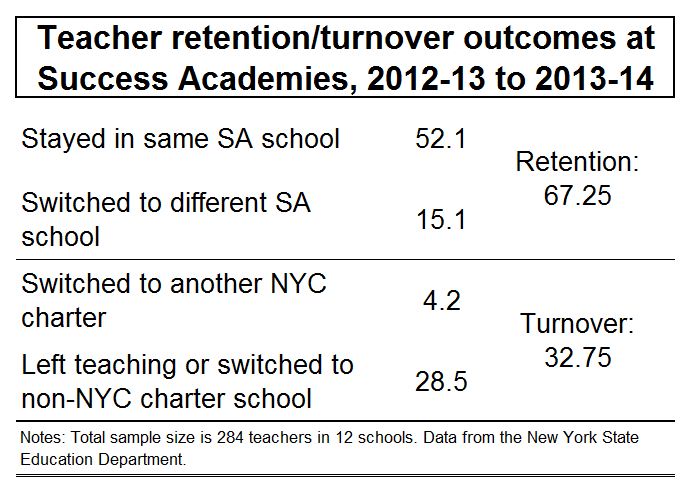Teacher Turnover At Success Academy Charter Schools
A recent New York Times article about the Success Academies, a large chain of New York City charter schools, focuses a great deal on the long working hours and heavy stress faced by teachers at these schools. The article reports that three Success Academy (SA) schools had teacher turnover rates above 50 percent. Officials from the network, however, dispute these figures, which they say are inflated by the fact that many teachers who leave SA schools simply transfer to other SA schools (i.e., they are counted falsely as leaving SA when they are in fact staying within the network).
In fact, SA officials claim that, when one account for these intra-network transfers, their true turnover rate across all their schools ("attrition from the network," in the article) between June 2013 and June 2014 was 17 percent, which is far lower than many critics suggest. Now, on the one hand, these ongoing debates about teacher turnover at SA schools, which have been occurring regularly for years, are a little strange. It is clear that SA teachers work unusually long hours in high stress, tightly regulated environments, and do so for salaries that are lower than those offered by most other professional jobs with similar working conditions. It is, therefore, hardly surprising that turnover would be high; indeed, high teacher churn, like student mobility, is in many respects part of the model of schools such as the Success Academies (and, of course, some turnover, such as that among poorly performing teachers or those who are not a good fit for their schools, can be beneficial).
On the other hand, however, SA officials are making an empirical claim about turnover at their schools, one that includes an interesting and somewhat unusual angle (intra-network mobility). And this claim is very easy to examine with teacher-level data that we happen to have available via a public records request. So, let’s take a quick look at turnover at SA between 2012-13 and 2013-14 (the latest year-to-year transition we have).
In our dataset, there were 284 teachers employed in 12 SA schools in 2012-13. The simple table below presents the distribution of turnover outcomes for these teachers in 2013-14.

As you can see, just over 52 percent of these teachers remained in the same school between 2012-13 and 2013-14, while an additional 15.1 percent switched from one SA school to another within the network. This means that SA officials’ claim -- that many teachers who leave their schools are just transferring within the network -- is correct, at least in these years. Simple turnover rates, in SA's case, are overstating "real" churn.
It also, however, means that roughly one in three SA teachers (32.8 percent) either switched to a different (non-SA) school, in NYC or elsewhere, or exited the teaching profession entirely. This is almost twice the rate of 17 percent provided by SA officials to the New York Times reporter.
It is unclear why their figures are so far off. The only possibility I can think of is that SA officials weren’t counting involuntary turnover (i.e., dismissals) – that is, their figure of 17 percent represents the percentage of teachers who left SA schools for reasons other than being fired. Voluntary and involuntary attrition are of course distinct outcomes with very different causes and policy implications, but it is nevertheless more than a little misleading for SA to claim without any elaboration that their total turnover rate was 17 percent, when it very clearly seems to have been much higher.
Finally, to reiterate, all this back and forth about SA teacher turnover is a little strange. High profile charter chains such as the Success Academies are constantly trumpeting how central to their approach are selective retention and demanding working conditions when it comes to their teachers. They also rely heavily on programs such as Teach for America, with its short term teaching commitments. Not all teacher turnover is "bad," and higher churn is in many respects baked into key elements of SA's approach. It seems inconsistent to quibble over levels or imply otherwise.

Matt, the table doesn't have
Matt, the table doesn't have a category for teachers who left SA and went to a district school, NYC or otherwise. Any data on that?
Just what I noticed.
Just what I noticed.
Hi Mark,
Hi Mark,
Unfortunately, we cannot make that determination, even within NYC, as the unique teacher IDs are different between sectors.
MD
Interesting - thanks for
Interesting - thanks for letting us know. BTW, excellent post.
Is it possible that SA's
Is it possible that SA's numbers are taking into account SA teachers that were promoted into school or network administration positions, which might be dramatic given SA's expansion? Perhaps those numbers are being counted in your numbers as "leaving the teaching profession" and in SA's account of staying in the network, even though these individuals are coaches/principals/deans/etc rather than teachers.
There are many teachers that
There are many teachers that are not really "fired", but choose to leave and to uphold image SA they say "fired". The teacher was already planning to leave and was then "asked" to leave. Successful teachers tend to leave, once they are certified to work elsewhere. Those that no longer want to teach stay in the network, to move to a different positions, and then leave.